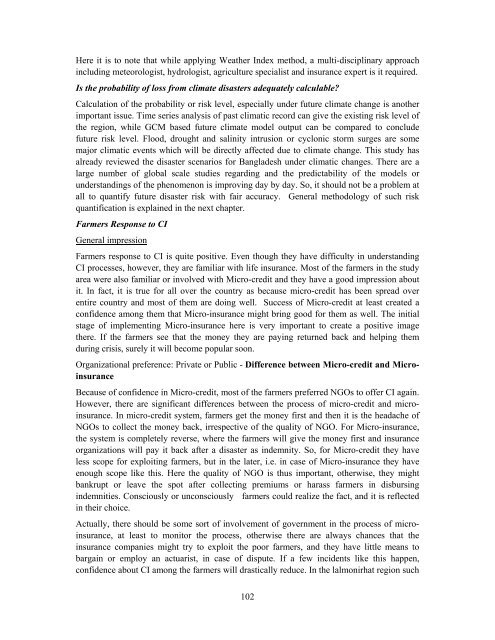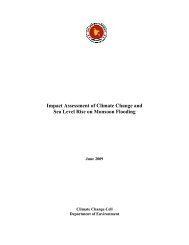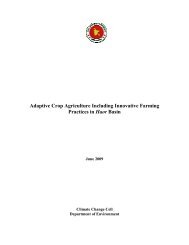Crop Insurance as a Risk Management Strategy in Bangladesh
Crop Insurance as a Risk Management Strategy in Bangladesh
Crop Insurance as a Risk Management Strategy in Bangladesh
Create successful ePaper yourself
Turn your PDF publications into a flip-book with our unique Google optimized e-Paper software.
Here it is to note that while apply<strong>in</strong>g Weather Index method, a multi-discipl<strong>in</strong>ary approach<br />
<strong>in</strong>clud<strong>in</strong>g meteorologist, hydrologist, agriculture specialist and <strong>in</strong>surance expert is it required.<br />
Is the probability of loss from climate dis<strong>as</strong>ters adequately calculable?<br />
Calculation of the probability or risk level, especially under future climate change is another<br />
important issue. Time series analysis of p<strong>as</strong>t climatic record can give the exist<strong>in</strong>g risk level of<br />
the region, while GCM b<strong>as</strong>ed future climate model output can be compared to conclude<br />
future risk level. Flood, drought and sal<strong>in</strong>ity <strong>in</strong>trusion or cyclonic storm surges are some<br />
major climatic events which will be directly affected due to climate change. This study h<strong>as</strong><br />
already reviewed the dis<strong>as</strong>ter scenarios for <strong>Bangladesh</strong> under climatic changes. There are a<br />
large number of global scale studies regard<strong>in</strong>g and the predictability of the models or<br />
understand<strong>in</strong>gs of the phenomenon is improv<strong>in</strong>g day by day. So, it should not be a problem at<br />
all to quantify future dis<strong>as</strong>ter risk with fair accuracy. General methodology of such risk<br />
quantification is expla<strong>in</strong>ed <strong>in</strong> the next chapter.<br />
Farmers Response to CI<br />
General impression<br />
Farmers response to CI is quite positive. Even though they have difficulty <strong>in</strong> understand<strong>in</strong>g<br />
CI processes, however, they are familiar with life <strong>in</strong>surance. Most of the farmers <strong>in</strong> the study<br />
area were also familiar or <strong>in</strong>volved with Micro-credit and they have a good impression about<br />
it. In fact, it is true for all over the country <strong>as</strong> because micro-credit h<strong>as</strong> been spread over<br />
entire country and most of them are do<strong>in</strong>g well. Success of Micro-credit at le<strong>as</strong>t created a<br />
confidence among them that Micro-<strong>in</strong>surance might br<strong>in</strong>g good for them <strong>as</strong> well. The <strong>in</strong>itial<br />
stage of implement<strong>in</strong>g Micro-<strong>in</strong>surance here is very important to create a positive image<br />
there. If the farmers see that the money they are pay<strong>in</strong>g returned back and help<strong>in</strong>g them<br />
dur<strong>in</strong>g crisis, surely it will become popular soon.<br />
Organizational preference: Private or Public - Difference between Micro-credit and Micro<strong>in</strong>surance<br />
Because of confidence <strong>in</strong> Micro-credit, most of the farmers preferred NGOs to offer CI aga<strong>in</strong>.<br />
However, there are significant differences between the process of micro-credit and micro<strong>in</strong>surance.<br />
In micro-credit system, farmers get the money first and then it is the headache of<br />
NGOs to collect the money back, irrespective of the quality of NGO. For Micro-<strong>in</strong>surance,<br />
the system is completely reverse, where the farmers will give the money first and <strong>in</strong>surance<br />
organizations will pay it back after a dis<strong>as</strong>ter <strong>as</strong> <strong>in</strong>demnity. So, for Micro-credit they have<br />
less scope for exploit<strong>in</strong>g farmers, but <strong>in</strong> the later, i.e. <strong>in</strong> c<strong>as</strong>e of Micro-<strong>in</strong>surance they have<br />
enough scope like this. Here the quality of NGO is thus important, otherwise, they might<br />
bankrupt or leave the spot after collect<strong>in</strong>g premiums or har<strong>as</strong>s farmers <strong>in</strong> disburs<strong>in</strong>g<br />
<strong>in</strong>demnities. Consciously or unconsciously farmers could realize the fact, and it is reflected<br />
<strong>in</strong> their choice.<br />
Actually, there should be some sort of <strong>in</strong>volvement of government <strong>in</strong> the process of micro<strong>in</strong>surance,<br />
at le<strong>as</strong>t to monitor the process, otherwise there are always chances that the<br />
<strong>in</strong>surance companies might try to exploit the poor farmers, and they have little means to<br />
barga<strong>in</strong> or employ an actuarist, <strong>in</strong> c<strong>as</strong>e of dispute. If a few <strong>in</strong>cidents like this happen,<br />
confidence about CI among the farmers will dr<strong>as</strong>tically reduce. In the lalmonirhat region such<br />
102





